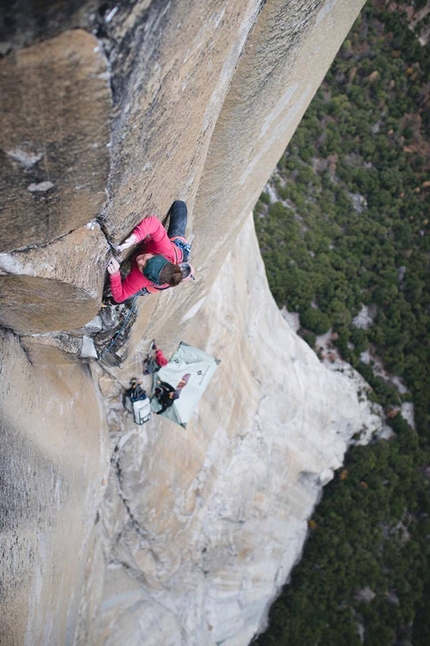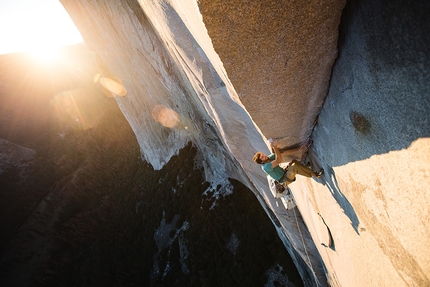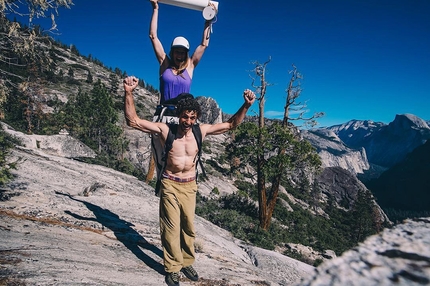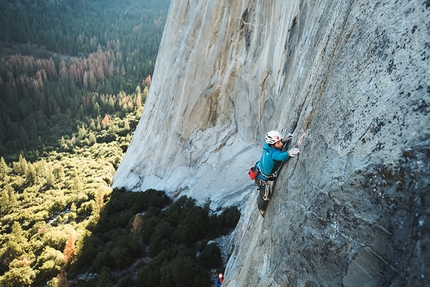Magic Mushroom: Jacopo Larcher, Barbara Zangerl and the magical big wall on El Capitan

 1 / 10
1 / 10 Jon Glassberg / Louder Than Eleven
Jon Glassberg / Louder Than Eleven
Six months ago Jacopo Larcher and Barbara Zangerl made the first repeat of Magic Mushroom, the huge big wall up El Capitan in Yosemite freed in 2008 by Tommy Caldwell together with Justen Song. The route follows an extremely logical line up the Big Stone for 30 pitches, but tackles a series of extremely smooth corners and boasts an 8b+ crux pitch, a thin overhanging crack, heartbreakingly just below the summit. As for El Nino in 2015 and Free Zodiac in 2016, Zangerl and Larcher both led all the harder pitches free. Both consider it one of the most difficult routes that have ever climbed. And both agree that Caldwell’s ascent in a mere 20 hours was... well, check out the interview below.
Why this route? In some respects it’s a rather unusual choice.
Jacopo: Good question... it was one of the few that hadn’t been repeated yet and this intrigued me. There was not much information on the internet and I was curious.
You too Barbara?
Barbara: Convincing me wasn't too difficult ;-) The alternative would have bee The Nose, but there were too many teams over there.
This was your third season in Yosemite, by now you know how to go about things. And so you immediately started trying the route ground-up.
Jacopo: To tell the truth, one always learns something new, year after year. The haulbags, and some cracks, are still a nightmare :-) We decided not to rappel from the summit, because we think this makes more sense. It’s nice to start from the bottom without knowing what lies in store; maybe, after days and days of effort, you reach a pitch that you just can’t climb, or you realise that the route is simply too difficult. These unknowns make the adventure more interesting; abseiling in from above removes a fundamental part of the overall experience. For us it was important to be able to climb all the way to the summit ground-up, before rappelling from the summit and working the final crux pitches. Obviously this takes more time; you’re slower and it is more hard work, but it’s all part of the game. And we had a significant advantage: the route had already been climbed free and we knew it was possible.
What was you first impression?
Barbara: The first impression was super, the second one was slightly less so because we had to clean many pitches and this took several days. Some of the cracks were completely filled with vegetation. During the the first days in particular the most important tool was a brush, not our climbing shoes.
Jacopo: Yes, the first five pitches are shared with Muir Wall so they were pretty clean, but the first real pitch of Magic Mushroom immediately proved to be challenging and made us realise that we’d have to invest a lot of time if we wanted to free climb the route. The crack was completely full of grass and it took a day to clean in order for us to try it. And this was only the first of many. Luckily the second part of the route is very overhanging and the pitches were far cleaner.
What climbing style did you adopt?
Jacopo: Well we didn’t reach the summit in a single push. We spent the first 5 days cleaning and working the pitches up to Mammoth Ledges, another 5 days to reach the 18th pitch, and another 8 days to climb to the top. We fixed some static ropes along the route. After climbing everything from the bottom, we rappelled twice from the summit, staying on the wall for various days in order to work the final hard pitches and do some filming. During this phase we’d already managed to free climb most of the pitches, mainly seconding though.
So how many days did you invest in the route?
Barbara: In total we stayed on the face for over 30 days, which means we spent most of our Yosemite time on Magic Mushroom. The fact is that you can’t really prepare in advance for a route like this one. The climbing is so special that you can’t train specifically for it, except on the actual wall, on the route itself. At first everything seemed impossible. That's why we spent so many days up there, trying each tough pitch until we found the best beta.
You said that it seemed impossible at first. Why? What’s the climbing like?
Jacopo: I don’t think I've ever tried such strange corners in 20 years of climbing! The first half of the route mainly follows cracks and slabs, while most of the hard pitches follows corners. The climbing is both technical and physical and you have to be really creative to understand how to unlock certain pitches. The footholds are almost non-existent, you have to do loads of knee-bars and constantly wedge your back... my bruises remained for ages! As Babsi mentioned, we needed a lot of time to "decipher" some pitches. The route is really continuous, just think that one of the crux pitches is 40 meters below the summit!
Barbara: The best pitch for me was the last one, the 5.14a, just below the top. An overhanging crack with a section right at the end which, at least for me, was extremely difficult. This is probably one of the best pitches I've ever climbed, just below the rim of El Capitan. This really is something special.
After working the route you descended and got ready for the final push
Barbara: Actually, somehow I never felt ready for the decisive attempt. My biggest problem was that last pitch just below the top. Although I could do the individual moves, I could never link them with with all the rest. It started to become nerve-wracking, and to make things worse time began to run out and we couldn’t afford to spend another day on just this pitch. Furthermore, Jacopo had it pretty sussed and we only had 12 days left… so it was clear that we’d at least try the route from the ground once and see how far we could get. Truth be told, I’d already resigned to the fact that I’d have to come back next year :-)
During the first two days you climbed fast, making short work of 18 pitches, some of which happened to be wet. So you got off to a superb start. But then ... you slowed down. What happened?
Jacopo: The real difficulties began :-) And of course we both wanted to lead all the hard pitches, this decision slowed us down even further. Those corners really are very complicated indeed!
Barbara: During the first 2 days of our final push we knew that everything had to run smoothly. That we had to climb all the pitches on our first go in order to achieve our daily goals. So there was no time for a breather. But when we reached the portaledge on the second day I felt pretty bad. I had an stomach infection, I couldn’t eat or sleep, I felt really sick. We thought we’d have to descend. This was certainly our first crux moment. I simply didn’t know if I could continue climbing upwards. What I did know though was that the next day I wouldn’t be able to do anything at all. Fortunately we were on track time wise and therefore we had a rest day, which was important for both of us. Then we continued climbing. I still didn’t feel perfect. Better, yes, but somehow I lacked energy and felt weak. But I was motivated to keep climbing.
In total you spent 11 days on the wall on that final push...
Jacopo: Time flew by. I’d become so used to living on the portaledge that I didn’t notice how time passed by so quickly. We had planned to be much slower on the second part, so it didn’t surprise us that we were having to spend so many days on the wall. After the first two days we chose to have a rest day, and then launch into the upper part with renewed energy. Since we knew we had enough time and food we tried not to "overdo" things and save energy. We almost never did more than 3, 4 pitches per day. We even rested two more days: the 8th and 10th. The first in order to wait for a pitch to dry, the second to recuperate some strength.
So when you launched upwards, how many days had you planned?
Jacopo: We knew we didn’t have enough time for a second attempt, so we decided to take enough food and water for 14 days. We had already stashed some gear along the route during the earlier attempts, so hauling the bags wasn’t all too strenuous. Fortunately we didn’t have to remain on the route for much longer, because we would have run out of water… we’d miscalculated how much water we’d need ;-) having said that, we had enough food to feed an army!
You climbed the route in December.
Barbara: We were extremely lucky with the weather. We only had a small snowstorm one night and a bit of rain the next morning, during our 4th day on the wall, otherwise the weather was always good and very hot. We couldn’t have asked for more. Sometimes we even climbed at night because it was too hot during the day, in December! During some of that period there wasn’t anyone on El Capitan. For several days we were the only climbers up there… it was fantastic. This doesn’t happen very often on El Cap.
How do you rate the route?
Jacopo: I think it's the longest, most beautiful and hardest climb I've ever done. It is much more challenging and complex than the other two routes we’ve climbed on El Cap. The line is very logical and every pitch is amazing. The climbing is so special and different that it represented a huge challenge for both of us
Barbara: For me, mentally, it was the greatest challenge I’ve ever faced. I’ve never wanted to succeed so much on a route as on this one. Twice I really risked failing, and I really had to dig deep to climb it all free. It’s difficult to compare with other climbs. Zodiac for example has 5 difficult pitches, 2 of which are harder, but Magic Mushroom has far more difficult pitches, and this makes it much harder overall. It’s like climbing Zodiac twice, one on top of the other.
Last question: what do you think of Tommy Caldwell’s free first ascent? And what can you say about his subsequent free ascent in 20 hours ...?
Barbara: Tommy's climb in the day is unthinkable. At the time the ascent didn't make huge headlines, but I think something like this should have deserved much more attention. He is definitely my personal hero. :-)
Jacopo: Yes, climbing all those hard and strange pitches in the day is simply unimaginable! What Tommy did is incredible! It is a pity that few know about his feat: for me it is one of the best achievements ever.
Magic Mushroom, El Capitan, Yosemite
30 pitches. The route shares the first 5 pitches of Muir Wall, then continues straight up to the Mammoth Ledges. After the Gray Ledge, it shares 3 pitches with El Corazon and rejoins the original aid line. The final 4 pitches follow the old aid route Jolly Roger. The route to the left of The Nose was first ascended with the use of aid in 1972 by Hugh Burton and Steve Sutton and freed in June 2008 by Tommy Caldwell and Justen Sjong with difficulties up to VI 5.14a / 8b+. A month later, drawing on a moment of utter inspiration, Caldwell then led all pitches free in a sub 24 hour push.
Link: FB Jacopo Larcher, jacopo-larcher.com, FB Barbara Zangerl, barbara-zangerl.at, La Sportiva, The North Face



 Copia link
Copia link









 See all photos
See all photos

























